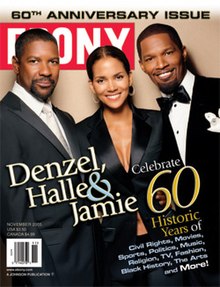Ebony (magazine)
This article reads like a press release or a news article and may be largely based on routine coverage. (June 2012) |
 | |
| Editor-In-Chief | Amy DuBois Barnett |
|---|---|
| Former editors | Bryan Monroe |
| Categories | Lifestyle Magazine |
| Frequency | Monthly |
| Publisher | Johnson Publishing Company |
| Total circulation (2011) | 1,235,865[1] |
| First issue | November 1, 1945[2] |
| Company | Johnson Publishing Company |
| Country | United States |
| Based in | Chicago, Illinois |
| Language | English |
| Website | www |
| ISSN | 0012-9011 |
Ebony is a monthly magazine for the African-American market. It was founded by John H. Johnson and has published continuously since the autumn of 1945. A digest-sized sister magazine, Jet, is also published by the Johnson Publishing Company.[3]
History
Ebony was founded by John H. Johnson in 1945.[4] The magazine has evolved over the years; in 1985 Ebony Man was started.[4] In 2010 it began a redesign process to update its longtime brand. In the past, the magazine was persistently upbeat, much like its postwar contemporary Life. Ebony, edited by John H. Johnson, has striven always to address African-American issues, personalities and interests in a positive and self-affirming manner. Its cover photography has focused on prominent African-American public figures, including actors and entertainers, and politicians, such as Dorothy Dandridge, Mariah Carey, Diana Ross, Michael Jackson, US Senator Carol Moseley Braun, President Barack Obama, Zoe Saldana, Tyrese Gibson and Tyler Perry.
For decades, advertisers created ads specifically for Ebony, which featured black models using their products.[citation needed] In the 21st century, many ads in widespread publications already feature black people; Ebony contributes to diversity by also running ads that feature non-black models.
In November 2010, the magazine featured a special 65th-anniversary edition cover featuring Taraji P. Henson, Samuel L. Jackson, Usher and Mary J. Blige. A second cover showcased Nia Long atop a birthday cake – Marilyn Monroe-style. The issue included eight cover recreations from historic and iconic previous covers of Ebony. Blair Underwood posed inside, as did Omar Epps and Jurnee Smollett. Mary J. Blige used her 1940s-style image from Ebony to update her Twitter profile picture.
National Public Radio marked this anniversary edition as the beginning of redesign of Ebony. Former White House Social Secretary Desiree Rogers, of the Obama administration, had become the CEO of the magazine.[5] In August 2008 the magazine had published a special 8-cover edition featuring the "25 Coolest Brothers of All Time". The lineup featured Jay-Z, Barack Obama, Prince, Samuel L. Jackson, Denzel Washington, Marvin Gaye, Muhammad Ali and Billy Dee Williams.[6]
In the 21st century, Ebony frequently makes headlines in the blogosphere and in the mainstream press. The November 2011 cover featured a pregnant Nia Long, reminiscent of the iconic image of actress Demi Moore featured naked while pregnant on a magazine cover two decades before. Some of Ebony′s more conservative readers disagreed with the cover choice, stating it inappropriate to feature an unwed, pregnant woman on the cover. The cover was featured in US Weekly and in a five-minute segment on CNN. Zoe Saldana was featured on the August 2011 issue, and some readers questioned a Black latina cover star. However, the Avatar actress seemed to open Ebony to a new segment: Americans of mixed African-American and Hispanic ancestry. Recent issues question whether President Obama is still right for black America and whether biracial Americans need more acknowledgement in today's society. In June 2010, Ebony ran an article about radio personality Robin Quivers, long-time sidekick of radio host Howard Stern, in which Quivers was asked if she considered herself a "sell out" for working with a predominantly white media. Quivers dismissed the question.
In December 2008, Google announced that it was scanning back issues for Google Book Search; all issues from November 1959 to December 2008 are available for free.[7] In 2010, the Johnson Publishing Company sold its historic building to Columbia College Chicago. It moved into a new building in 2011. The company also recently sold a share to Chase Bank so as to secure more cashflow for Ebony, Jet and the Johnson-owned cosmetics line, Fashion Fair.[citation needed]
See also
References
- ^ "eCirc for Consumer Magazines". Audit Bureau of Circulations. June 30, 2011. Retrieved December 1, 2011.
- ^ Newseum.org Error in Webarchive template: Timestamp not a number.
- ^ Editors (November 1992). "From Negro Digest to Ebony, Jet and Em – Special Issue: 50 Years of JPC – Redefining the Black Image". Ebony. Retrieved January 3, 2009.
{{cite web}}:|author=has generic name (help) - ^ a b Satya P. Krishnan; et al. (1997). "Coverage of AIDS in Popular African American Magazines" (PDF). Health Communication. 9 (3). Retrieved February 26, 2016.
{{cite journal}}: Explicit use of et al. in:|author=(help) - ^ Cheryl Corley, "'Ebony,' 'Jet' Parent Takes A Bold New Tack", NPR, 22 September 2011
- ^ "Ebony: The 25 Coolest Brothers Of All Time". TaleTela. July 7, 2008. Retrieved January 3, 2009.
- ^ Dave Foulser (December 9, 2008). "Search and find magazines on Google Book Search". Google. Retrieved January 3, 2009.
External links
- ebony Official website
- Back issues on Google Book Search
- Langston Hughes, "Publishing history of Ebony", Ebony, November 1965 (20th Anniversary Issue
- "John H. Johnson's oral history- video excerpts", The National Visionary Leadership Project
